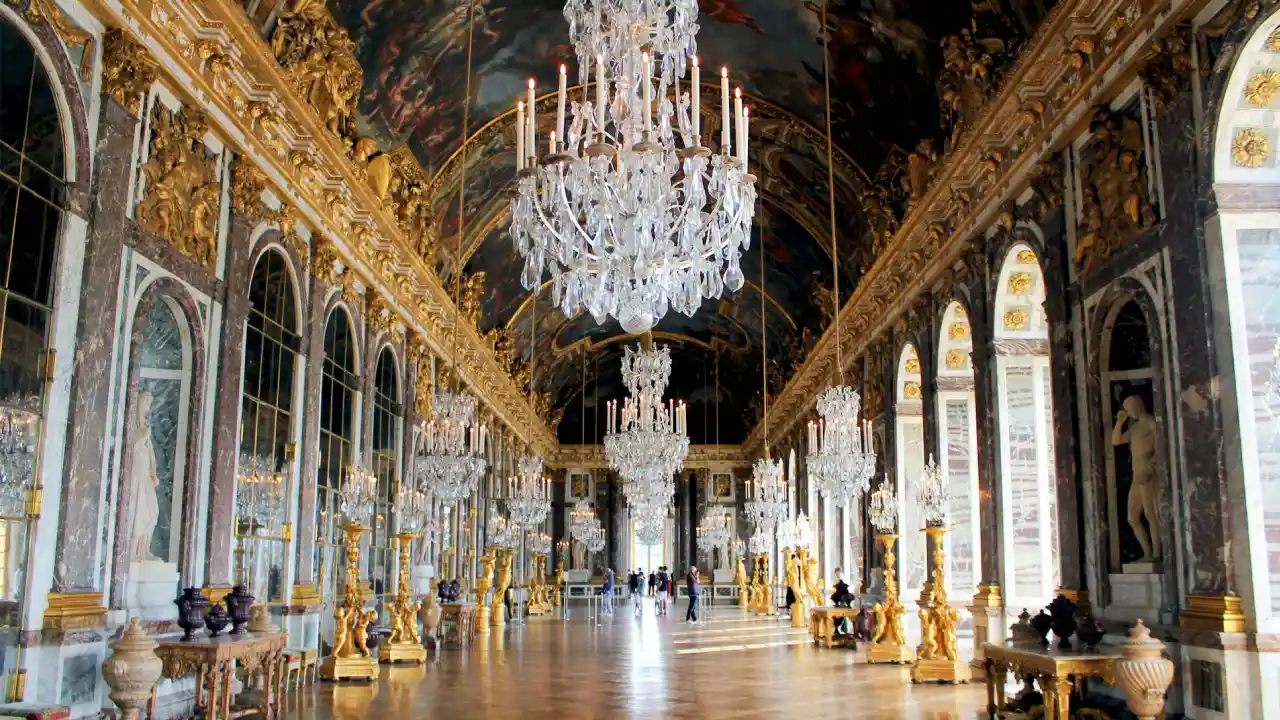Discover the best museums in Versailles, including The Compagnonnage Museum and The Chariot Museum. Explore history, art, and culture in this iconic city!

Customer support to help you with everything you need from 8.00 a.m. to 6.00 p.m.

Choose the best option for your needs and preferences and avoid the lines booking here

Enjoy art and history in Versailles, French monarchy’s masterpiece

Versailles, renowned for its grand palace and opulent gardens, is also home to several fascinating museums that offer insights into the city’s rich cultural and historical heritage. Each museum in Versailles has its unique charm and focus, ranging from art and craftsmanship to historical events and royal transportation. This article delves into five notable museums in Versailles: The Lambinet Museum, The Compagnonnage Museum, The Museum of the Ball Game Hall, the Palace of Versailles, and The Chariot Museum.
The Lambinet Museum, housed in an elegant 18th-century mansion, provides a comprehensive overview of Versailles’ local history and art. This museum was established in 1932 and named after its last private owners, the Lambinet family. The building itself is a fine example of classical French architecture, with its charming facade and well-preserved interiors.
The Lambinet Museum boasts an impressive collection of paintings, sculptures, and decorative arts from the 18th and 19th centuries. Visitors can admire works by prominent artists such as Jean-Baptiste Oudry, Charles Le Brun, and Jean-Antoine Houdon. The museum’s art collection is particularly strong in showcasing portraits and landscapes that reflect the cultural and social life of the period.
In addition to its art collections, the Lambinet Museum also houses a variety of historical artifacts related to the city of Versailles. These include furniture, ceramics, and textiles that illustrate the everyday life of its inhabitants over the centuries. One of the museum’s highlights is the reconstruction of a typical 18th-century Parisian salon, complete with period furniture and decor.
The Lambinet Museum frequently hosts special exhibitions and cultural events, enhancing its role as a vibrant center for local history and art. These temporary exhibitions often focus on specific themes or artists, providing visitors with new perspectives on the museum’s collections. The museum also organizes educational workshops and guided tours, making it an engaging destination for both art enthusiasts and history buffs.
The Compagnonnage Museum, also known as the Museum of the Guilds, celebrates the rich tradition of French craftsmanship. Located in a historic building that was once the home of the king’s stable master, the museum showcases the skills and artistry of the “compagnons” – members of France’s historic guilds of craftsmen.
The museum’s exhibits cover a wide range of crafts, including woodworking, metalworking, masonry, and culinary arts. Visitors can marvel at the intricate models and tools used by the compagnons, as well as the finished products that demonstrate their exceptional skills. The displays highlight the technical precision and creativity that characterize the compagnonnage tradition.
The Compagnonnage Museum offers various educational programs and workshops aimed at preserving and promoting traditional craftsmanship. These programs provide hands-on experiences for visitors of all ages, allowing them to learn about the techniques and materials used by the compagnons. The museum also collaborates with contemporary artisans, showcasing their work and fostering a connection between past and present craftsmanship.
The museum not only celebrates the history of the compagnonnage movement but also underscores its ongoing relevance. By highlighting the enduring values of excellence, mentorship, and community, the Compagnonnage Museum serves as a testament to the importance of preserving and passing down traditional skills in an ever-evolving world.
The Museum of the Ball Game Hall (Musée de la Salle du Jeu de Paume) is dedicated to one of the pivotal moments in French history – the Tennis Court Oath of 1789. This historic event, which took place in the Ball Game Hall, marked the beginning of the French Revolution. The museum is located in the very room where members of the Third Estate gathered to swear their famous oath, pledging to remain united until a new constitution was established.
The museum’s exhibits focus on the events leading up to the French Revolution and the significant role played by the Tennis Court Oath. Visitors can view original documents, portraits, and artifacts related to the revolutionaries and their struggle for political reform. The museum also features a detailed timeline that traces the key events of the Revolution, providing a comprehensive understanding of this transformative period in French history.
By preserving the site of the Tennis Court Oath and presenting its history in an accessible and engaging manner, the Museum of the Ball Game Hall ensures that the legacy of the French Revolution remains alive and relevant. It serves as a reminder of the power of collective action and the enduring struggle for democratic ideals.
The Palace of Versailles, one of the most famous landmarks in the world, is a symbol of absolute monarchy and French opulence. Originally a hunting lodge for Louis XIII, it was transformed and expanded by Louis XIV into the magnificent palace we see today. The palace complex includes the main building, the expansive gardens, and several smaller structures such as the Grand Trianon and the Petit Trianon.
Among the many splendors of the Palace of Versailles, the Hall of Mirrors (Galerie des Glaces) stands out as a breathtaking masterpiece. This grand gallery, with its 357 mirrors reflecting the light from the opposite windows, creates an illusion of endless space and light. The ceiling paintings by Charles Le Brun celebrate the achievements of Louis XIV, and the hall’s opulent decor exemplifies the Baroque style’s emphasis on grandeur and drama.
The King’s and Queen’s State Apartments are another highlight of the palace. These lavishly decorated rooms served as the official living quarters for the royal family and were the setting for various court ceremonies. The apartments are adorned with exquisite tapestries, paintings, and furniture, showcasing the luxurious lifestyle of the French monarchy.
The gardens of Versailles, designed by André Le Nôtre, are an integral part of the palace’s splendor. Covering nearly 2,000 acres, the gardens feature meticulously landscaped lawns, ornate fountains, and classical statues. The Grand Canal and the various groves, or “bosquets,” provide scenic views and tranquil spaces for visitors to explore.
The Palace of Versailles is not only an architectural marvel but also a site of immense historical importance. It was the seat of political power in France from 1682 until the French Revolution in 1789. The palace has witnessed numerous significant events, including the signing of the Treaty of Versailles in 1919, which ended World War I.
Today, the Palace of Versailles is a UNESCO World Heritage site and one of the most visited tourist attractions in the world. Efforts to preserve and restore the palace and its gardens ensure that this cultural treasure remains accessible to future generations. The palace also hosts temporary exhibitions, concerts, and other cultural events, making it a dynamic center for arts and history.
The Chariot Museum (Musée des Carrosses) offers a fascinating glimpse into the world of royal transportation. Located in the Great Stables of the Palace of Versailles, the museum houses a unique collection of carriages, sleighs, and other vehicles used by the French royal family.
The museum’s collection includes several magnificent royal carriages, each a masterpiece of craftsmanship and design. These carriages were used for various ceremonial occasions, such as coronations, weddings, and state visits. The ornate decorations, including gilded sculptures and intricate paintings, reflect the opulence and grandeur of the French court.
In addition to the carriages themselves, the museum provides historical context about the use and significance of these vehicles. Visitors can learn about the role of carriages in royal ceremonies and the evolution of transportation technology over the centuries. The museum also highlights the craftsmanship involved in creating these elaborate vehicles, showcasing the skills of the artisans who built and decorated them.
The Chariot Museum also features a collection of royal sleighs, which were used for winter travel and festive occasions. These sleighs are beautifully decorated and provide a charming contrast to the grand carriages. The museum’s exhibits also include other types of vehicles, such as sedan chairs and litters, offering a comprehensive overview of royal transportation.
The Chariot Museum offers educational programs and workshops that provide insights into the history and craftsmanship of royal transportation. These programs are designed to engage visitors of all ages, making the museum an educational and entertaining destination for families and school groups.
The museums of Versailles offer a rich and diverse exploration of the city’s cultural and historical heritage. From the art and artifacts of the Lambinet Museum to the craftsmanship celebrated in the Compagnonnage Museum, and from the revolutionary history preserved in the Museum of the Ball Game Hall to the grandeur of the Palace of Versailles and the unique collections of the Chariot Museum, each museum provides a unique window into the past.
These museums not only preserve and showcase the legacy of Versailles but also engage and educate visitors, ensuring that the stories and achievements of this remarkable city continue to inspire future generations. Whether you are an art lover, a history enthusiast, or simply curious about the past, the museums of Versailles offer something for everyone, making them an essential part of any visit to this historic city.
The location of Versailles was formerly a small community with a church. In order to hu…
Given that Versailles is associated with Louis XIV and vice versa, Louis XIV appears to…
Louis XV, sometimes referred to as Louis the Beloved was formerly known as the King of…
Louis XVI became king at a young age when he was just around twenty years old…
